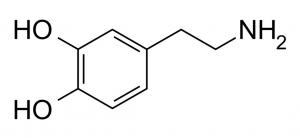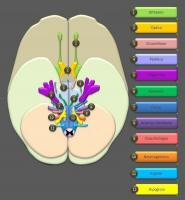Papez circuit: what it is and what brain structures it includes
The Papez circuit refers to a series of brain structures related to the processing of emotions, memories and learning.
What we know today as the limbic system was a theoretical model that developed over the years and the Contributions of different scientists in order to establish the bases of the functioning of emotions human.
In this article we explain what this circuit consists of and what its structure is, as well as its main authors and contributions.
- Related article: "Parts of the human brain (and functions)"
What is the Papez circuit?
The Papez circuit defines a set of brain structures located in what we now know as limbic system and involved in the management of emotions, memory and learning. It was proposed in 1937 by the American neurologist, James Papez, with the aim of theorizing a neuroscientific model capable of explaining the functioning of human emotions.
Papez postulated the existence of a set of Serial connections linking the hippocampus to the hypothalamus, thalamus, and cingulate cortex, and these back to the hippocampus
. Although the model involved what Paul Broca called "the limbic lobe" (which included the medulla olfactory, cingulate gyrus, and hippocampus), also included other subcortical structures within the diencephalonThis model approached emotions as a function of activity generated in the cingulate cortex. According to him, the projections of this region towards the hypothalamus and the mammillary bodies would allow the cortical regulation of responses. emotional pathways from top to bottom and the thalamocortical pathway would be responsible for converting sensations into perceptions, feelings and memories.
It should be noted that, although Papez took practically all the credit, The theoretical model of him was based on previous research by the German physician and philosopher Christofredo Jakob., who developed a theory about the limbic system and the central mechanisms of emotional processing many years before that the circuit be attributed to Papez (later his contributions were recognized and the circuit was renamed "de Jakob-Papez").
MacLean's contributions
In 1949, American neuroscientist Paul Maclean postulated a new neuroanatomical model of emotions: the triune brain, a model more in line with current knowledge. MacLean's model took the ideas of Papez and those of Cannon and Bard's theory, according to which emotional stimuli would be capable of provoking both the feeling of emotion in the brain and its expression in the nervous system peripheral; that is, emotion and reaction would occur simultaneously.
MacLean also integrated into his model the knowledge provided by the studies of Klüver and Bucy, who had shown that bilateral removal of the temporal lobes in monkeys led to a characteristic set of behaviors that included, among other symptoms such as hypersexuality or increased exploratory behaviors, loss of reactivity emotional. Some studies indicated that the temporal lobes had a key role in emotional processing.
MacLean's extended model divided the brain into three parts: first, the reptilian brain, the oldest in evolutionary terms and the one that houses primitive emotions such as fear or aggression; second, the mammalian or visceral brain, responsible for shaping primitive emotions and for elaborating more social emotions, would include many of the components of the Papez circuit; and third, the new brain, or neocortex, which connects emotions to cognition and exerts top-down control over emotional responses driven by other systems.
MacLean's essential idea was that emotional experiences involved the integration of external sensations with the information that comes from the organism; that is, the events of reality would cause bodily changes. This integration would be responsible for generating the final emotional experience and who carried it out was the visceral brain, which he later called the limbic system.
- You may be interested in: "MacLean's triune brain theory: what it is and what it proposes"
Structures of the Papez circuit and its functions
Papez's circuitry included cortical and subcortical structures such as the hippocampus, fornix, corpus mammillary, the mammillothalamic tract, the anterior nuclei of the thalamus, the cingulate gyrus, and the cortex entorhinal.
When the circuit was expanded and reconceptualized as the limbic system, other structures such as the amygdala complex or the orbitofrontal cortex were added. Let's see what each of them consists of:
1. Hippocampus
A fundamental structure in the human brain, is involved in memory consolidation and learning.
- You may be interested in: "Hippocampus: functions and structure of the memory organ"
2. fornix
Brain structure composed of white matter that originates in the hippocampus and that Serves as a connector between various areas of the brain, mainly from the hippocampus to the hypothalamus and from one hemisphere to another.
3. Mamillary bodies
Located at the base of the brain make a connection between the amygdala and the hippocampus, and participate in memory processes.
4. mammillothalamic tract
This structure connects the mammillary bodies with the anterior nuclei of the thalamus.
5. Anterior nucleus of the thalamus
Located in the thalamus, they receive fibers from the mammillary bodies forming the mammillothalamic tract and are involved in processes that have to do with memory, learning and certain emotional behaviors.
6. cingulate gyrus
It is a cerebral gyrus with important functions within the limbic system., such as the formation of emotions and the processing of information related to behavior, memory and learning.
7. entorhinal cortex
This structure is located in the medial temporal lobe and is involved in learning and orientation functions, with an important role in autobiographical and spatial memory.
8. tonsillar complex
Set of nuclei located in the temporal lobes with processing and storage functions of emotional reactions. They also appear to play an important role in modulating memory and in the response to sex hormones.
9. orbitofrontal cortex
It is a brain region located in the frontal lobe and involved in cognitive processing: decision making and expectations formation.
The role of the amygdala
One of the best ways to understand the functioning of a brain structure is by studying and comparing patients with injuries and healthy subjects. Regarding the amygdala, today we know that Lesions in this structure can lead to impaired processing of faces and other social cues.. And if the lesion is bilateral and deep, typical signs of Klüver-Bucy syndrome may appear, such as hyperorality, passivity or strange eating behaviors, among others.
We know that the amygdala is a structure involved in fear conditioning.. In this sense, an investigation described the case of a man with a tonsil injury right showing a startle response to a sudden outburst significantly diminished. The subject also appeared to become immune to fear conditioning.
In another similar case, it was observed that one of the patients with bilateral damage to the amygdala did not respond to the conditioning of aversive stimuli. In contrast, another subject with hippocampal lesions was able to successfully acquire fear response conditioning, although he lacked explicit recollection of how he had acquired it. The latter would indicate that the amygdala plays a fundamental role in the processing and conditioning of fear.
Lastly, with regard to memory consolidation, it has been confirmed that patients with amygdala damage do not show improved recall of emotional aspects of an event or occurrence (compared to non-emotional aspects) emotional). Studies carried out with positron emission tomography show that elevated levels of the metabolism of glucose in the right amygdala could predict the memory of positive or negative emotional stimuli up to several weeks after.
Bibliographic references:
- Papez, J. W. (1937). A proposed mechanism of emotion. Arch. Neurol. Psychiatry 38, p. 725 - 743.
- Pessoa, L., & Hof, P. R. (2015). From Paul Broca's great limbic lobe to the limbic system. Journal of Comparative Neurology, 523(17), pp. 2495 - 2500.


